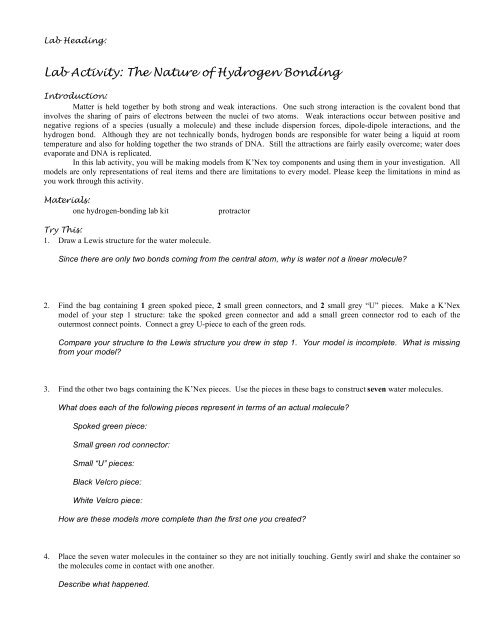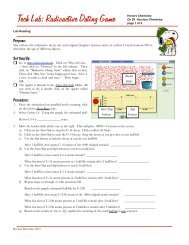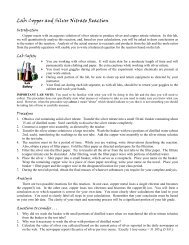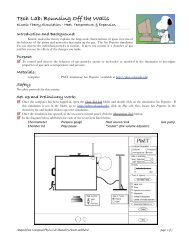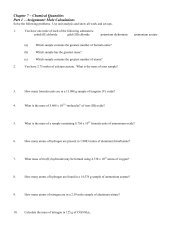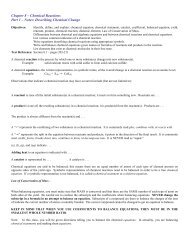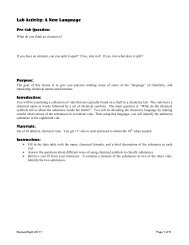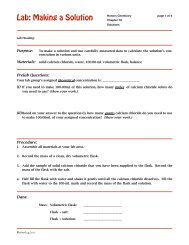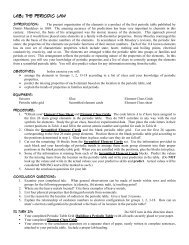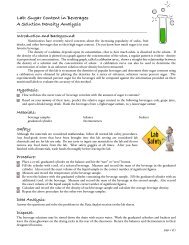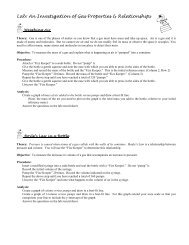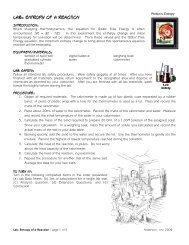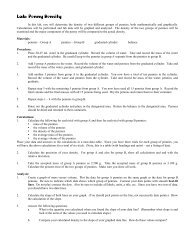Lab: Hydrogen Bonding - Honors Chemistry Coursework
Lab: Hydrogen Bonding - Honors Chemistry Coursework
Lab: Hydrogen Bonding - Honors Chemistry Coursework
You also want an ePaper? Increase the reach of your titles
YUMPU automatically turns print PDFs into web optimized ePapers that Google loves.
<strong>Lab</strong> Heading:<strong>Lab</strong> Activity: The Nature of <strong>Hydrogen</strong> <strong>Bonding</strong>Introduction:Matter is held together by both strong and weak interactions. One such strong interaction is the covalent bond thatinvolves the sharing of pairs of electrons between the nuclei of two atoms. Weak interactions occur between positive andnegative regions of a species (usually a molecule) and these include dispersion forces, dipole-dipole interactions, and thehydrogen bond. Although they are not technically bonds, hydrogen bonds are responsible for water being a liquid at roomtemperature and also for holding together the two strands of DNA. Still the attractions are fairly easily overcome; water doesevaporate and DNA is replicated.In this lab activity, you will be making models from K’Nex toy components and using them in your investigation. Allmodels are only representations of real items and there are limitations to every model. Please keep the limitations in mind asyou work through this activity.Materials:one hydrogen-bonding lab kitprotractorTry This:1. Draw a Lewis structure for the water molecule.Since there are only two bonds coming from the central atom, why is water not a linear molecule?2. Find the bag containing 1 green spoked piece, 2 small green connectors, and 2 small grey “U” pieces. Make a K’Nexmodel of your step 1 structure: take the spoked green connector and add a small green connector rod to each of theoutermost connect points. Connect a grey U-piece to each of the green rods.Compare your structure to the Lewis structure you drew in step 1. Your model is incomplete. What is missingfrom your model?3. Find the other two bags containing the K’Nex pieces. Use the pieces in these bags to construct seven water molecules.What does each of the following pieces represent in terms of an actual molecule?Spoked green piece:Small green rod connector:Small “U” pieces:Black Velcro piece:White Velcro piece:How are these models more complete than the first one you created?4. Place the seven water molecules in the container so they are not initially touching. Gently swirl and shake the container sothe molecules come in contact with one another.Describe what happened.
5. Pick up the connected array of water molecule models and spread it out on a flat surface without breaking any of the Velcroconnections.Are there any connections that shouldn’t occur? How do you know this to be the case?6. Return the connected array to the container and place the lid on the container. Shake the container vigorously for severalseconds. Open the container.Describe what you observed.7. Repeat steps four through 7 two more times.Are there any differences in your observations? If yes, explain. If no, why not?8. Connect the set of seven water molecule models in a fixed pattern so that each of the Velcro patches on a central watermolecules model is connected to a complementary Velcro patch on another water molecule.Show this model to your teacher. Your instructor needs to initial this to verify it was done correctly.Additional Questions:1. Use a protractor to measure the bond angle in the water molecule model. How does it compare to the bond angle of anactual water molecule?2. Between what two parts of this model are the representative hydrogen bonds formed?3. What physical change is modeled when individual water molecules are allowed to contact each other with gentle swirling?What does vigorously shaking the container represent and what physical change of water is being modeled?4. What would have to change in the model for water to have had a chemical change? How would you do this? Could thischange occur if you shook the container really hard? What does this suggest about the quantity of energy needed to break ahydrogen bond versus the energy needed to break a covalent bond?5. In your text book, find the term equilibrium and define it (in your own words).Are the connections the same after each round of shaking and bringing the water molecules back together again?How does this relate to the idea of equilibrium?6. What state of water is modeled in step 8? Explain how you know this to be the answer?7. In terms of the model, list as many points as you can where the modeled matched actual matter (water).In terms of the model, list as many points as you can where the model diverged from reality.To Turn In:<strong>Lab</strong> sheets – neatly and completely filled outAnswers to the additional questions- written in complete sentences on a separate sheet of paper and attached to the lab sheetConclusion- written in neat and complete sentences and attached to the lab sheetThis is due – ready to turn in – at the start of class on_________________________________________________


